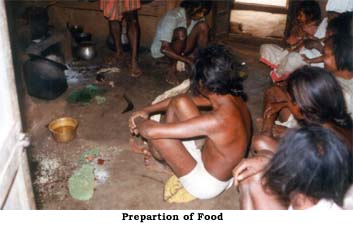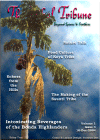Food Culture of Koya Tribe
|
Food is the basic need of the all-living creatures and man is no exception to it. It is only in case of human that food being associated with the designed behavior reveals the existence of what we call ‘culture’. From procurement to consumption, a human being follows a pattern learnt from the predecessors or contemporaries. It is not instinctive as in non-human animals. Thus, the researchers in human sciences have found ‘food’ intake as very interesting behavioral character of each community Food culture relates to a complex system, where environment, technological capacity, physiological tolerance, preference and prohibitions etc. play considerable roles. The primitive communities, who have kept themselves confined to mountainous forest regions for centuries, are interesting societies for inquisitive modern minds who want to learn the intricacies of food system. It is also a concern for development agencies that want to eradicate under nutrition among such people. For them, the present information on the Koya Tribe of Orissa-Andhra Pradesh border area may be interesting. The Koya inhabit the rugged terrain on the Eastern Ghats (east-coast India), mentioned in ‘Ramayana’ as "Dandakaranya’. They are medium height, thinly built people with dark-brown skin and speak a language of Dravidian family. They can communicate with the other non-tribal in local dialect, which is mixed with Oriya and Telugu. Their inaccessible habitat was encroached by non-tribal people of neighboring areas, but in a large way by the refugees from erstwhile East Pakistan (now Bangladesh) since 1960. Influx of large number of out side people with alien culture caused certain changes in the food procuring sources of the Koya, who were inefficient food producers. No other tribal communities of Orissa had to face this type of eco-pressure in recent history. It came all on a sudden due to the entry of the non tribal refugees in the area. These forest-dependent people lost much of their food sources and suffered. It is worthwhile to not that human groups cannot be forced to adapt to alien food materials and dietary practices. The habitat occupied by the Koya is extensive on the Eastern Ghats, on 3000 feet elevation from sea level. It receives fair amount of rainfall and the forest was luxurious. The forest was once very rich in vegetation and animals. The Koyas cultivate some minor millets, oil seeds and vegetables around their villages. They also supplement their diet with edible roots, fruits and flowers available in the forest and meat available from hunting. These people in their traditional culture eat variety of meat either hunted or reared. After settlement of the refugees, destruction of the forest and restriction on hunting, the Koya have changed their food habit in last three or four decades. The Koya living in Kalimela and surrounding region of Orissa (bordering Andhra Pradesh and Chhatisgarh), have now made settled cultivation of paddy and other millets on low land and are producing most food items rather than going for collection and hunting (depending on availability in the neighborhood). Although the Koyas do not consider rice as staple food item like other rice-eating people, they grow paddy, along with ‘suan’ (a kind of millet), maize etc. They grow some kind of pulses like ‘biri’ (black gram) and ‘kandula’. Along with vegetables, they grow, cowpea, broad bean, brinjals, chili, horse gram etc. Tobacco is not a food for stomach but very much used as smoking and chewing item. After the arrival of the rice-eating refugees, the Koyas started giving importance to paddy. The excess amount of paddy after their own consumption is bartered with or sold to the refugee neighbors.
Apart from, cultivation of domesticated plants, they rear some animals for own consumption, ritual sacrifice and earning money. As hunting practices are almost abandoned, their meat requirement is partly met from domesticated animals. Cattle like buffaloes, cow, goats and pigs are part of almost all Koya households. Paddy cultivation on low land requires buffalo and bullock as draught animals. Previously, the cow was also used for ploughing, but now they have learnt milking of cows and selling milk to tea stalls or to the refugees or make cheese and ‘ghee’ for selling. Pigs, goats and fowls are used as source of income or ritual sacrifice or consumption. The Koyas are veteran beefeaters, but now they are abandoning the practice or hiding from the investigators to become acceptable to the neighboring Hindu people. Milk and eggs were not consumed under belief that such practices would hamper growth of cattle and fowls. But cockfights that a kind of gambling with betting during the market days, earn them some cash money. The eggs and hens are used in most rituals, either religious or magical cure for illness. After development of the area, many non-tribal people have increased market value of fowls, eggs and goats. Forest-dependent Food Materials: Nature is very kind to this people. From very early morning team of young women enter the proximal forest to collect flowers of ‘Mohua’ (Bassia latifolia) tree in the spring and summer. In these seasons they collect jackfruit, mango, kendu fruit (whose soft leaves used as tobacco roll for cigars). There are many other berries and tamarinds. But the ‘Mohua’ flowers get most attention. The other fruits are consumed instantly, but the ‘Mohua’ flowers and fruits are also sun-dried and stored for making their cherished wine and oil extraction. Edible oil and oil for hair and body massage are obtained from ‘Mohua’, ‘kangula’, ‘kendu’, ‘rasi’ or ‘til’ and ‘alsi’ (Black Niger). During the rainy season, fruits become less and underground tubers, bamboo shoots and various types of mushrooms fill in the vacancies.
‘Mohua’ flower is fermented and produced their desired wine ‘Srate’ or ‘Urma', a golden color drink rated high by all tribal people. Rice is fermented with yeast to make common liquor ‘Landa’, which is consumed throughout the year. It is considered as food supplement. In the spring and summer, they climb up palm trees or sago-palm tree, tap oozing juices from the incised flowers. The juice mixed with yeast and given a daylong exposure to the sun, is transformed into liquor to keep them happy in the afternoon. Consumption of intoxicating drink is an essential part of not only the Koya but also all the tribes living difficult life. Food Preparation and Dining Habit: The adult Koya persons take two major meals, at around 11a.m. and 7p.m. But kids do not adhere to this norm. They are given in between small food and also they consume any edible fruit item they collect from nature. In meal, they usually consume a gruel made of rice and maize or millet. They have started consuming rice as gruel or soaked-rice, recently after exposure to other people. They do not have elaborate cooking by frying or using condiments. Mostly the raw staffs are boiled. Along with this gruel, sometimes pulses and leafy vegetables are consumed. They are very fond of tamarind and chili to make the food tasty. If fish or meat is available, they become very happy.
During the major meals, the entire family sits together in the open space keeping the cooked food in the center. If any member remains absent due to engagement, his/her food is kept separated. No food is wasted or kept for consuming later on. No gender wise discrimination is observed for food distribution. Food is served as per the capacity to consume. As in the most rural and primitive societies, there are some belief system accompanied with items of food, time and gender. Not only non-vegetarian food items, but also many vegetable items are included in the list of prohibition. Such belief are traditionally derived probably out of ancient observation, which may sound as superstitions to people with modern knowledge. In the following table a few such food items are enlisted with the reasons of prohibitions associated with them.
Prohibition for pregnant and lactating women
|
Photographs : All the photographs by Hrudaya Panigrahi
References :






